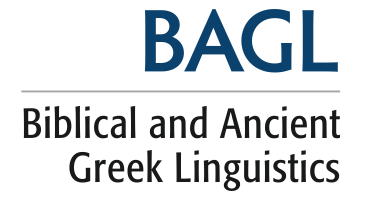10.1 | Paul L. Danove Villanova University, Villanova, PA, USA The New Testament presents twenty-two verbs that grammaticalize the resultant
state of an entity undergoing change. This article introduces the method of analysis
and description and resolves these verbs into five groups according to the manner in
which they grammaticalize resultant state. The introductory discussion develops the
method of semantic, syntactic, and lexical analysis and description. The discussion
then describes the licensing properties of the verbs in each group, specifies the
lexical realization of all observed required complements of the verbs, clarifies the
verbs’ interpretation, and illustrates their translation. Keywords: Greek, lexical, semantic, syntactic, resultant, resultative, verb |
10.2 | Nicholas List University of Cambridge, Cambridge, UK Corpus linguistic research often necessitates large amounts of data
(especially for Natural Language Processing tasks), yet this is exactly where
ancient language corpora are most deficient. Many ancient language corpora increase
their size by extending the temporal coverage of the corpus, allowing for diachronic
analysis over an enlarged dataset. Because of this, less attention has been given to
the compilation of synchronic corpora for ancient languages. Since temporal
demarcation must be strictly controlled, other means of increasing corpus size must
be explored. This paper considers a number of important theoretical considerations
for the construction of a corpus for Koine Greek, including representativeness,
size, and temporal coverage. While this study does present a corpus for Koine Greek,
its primary aim is to foreground the particular theoretical challenges that face
linguists engaged in synchronic corpus design for ancient languages. Keywords: corpus design, corpus linguistics, Koine Greek, synchronic |
10.3 | Aaron Michael Jensen Adrian, Michigan, USA This article examines passages where the typically corrective ἀλλά and the
typically explanatory γάρ are claimed by BDAG to have an inferential sense. By
demonstrating that the inferential senses are unnecessary and that here specialized
manners of correction and explanation persist, it serves to support an approach to
conjunction lexicography which recognizes the fundamental unity of conjunction
semantics, known as the “core constraint” approach. Keywords: conjunctions, core constraint, ἀλλά, γάρ |

